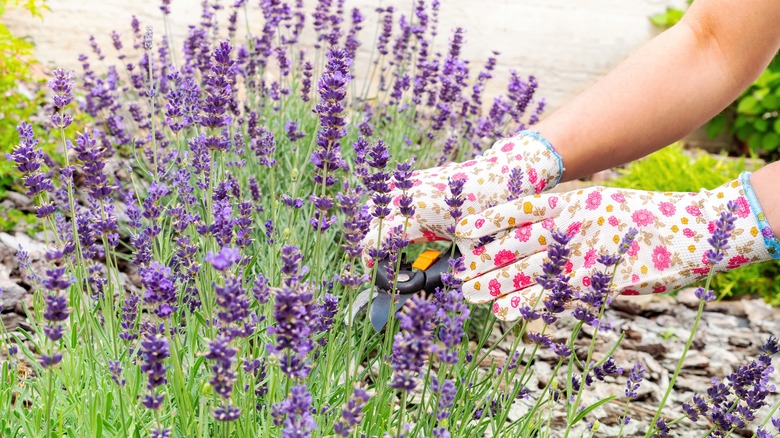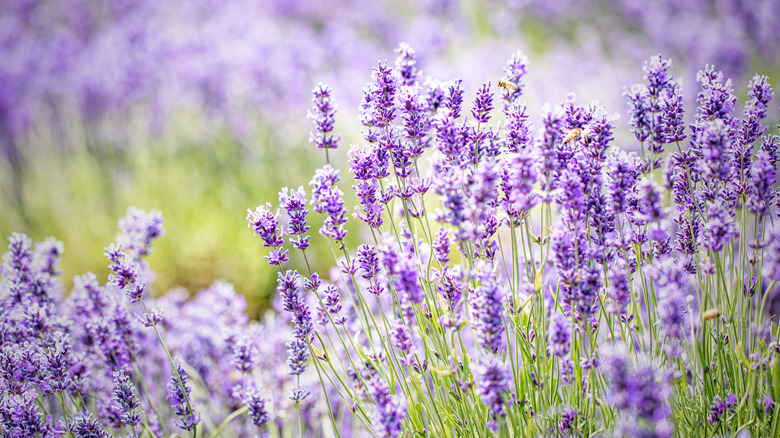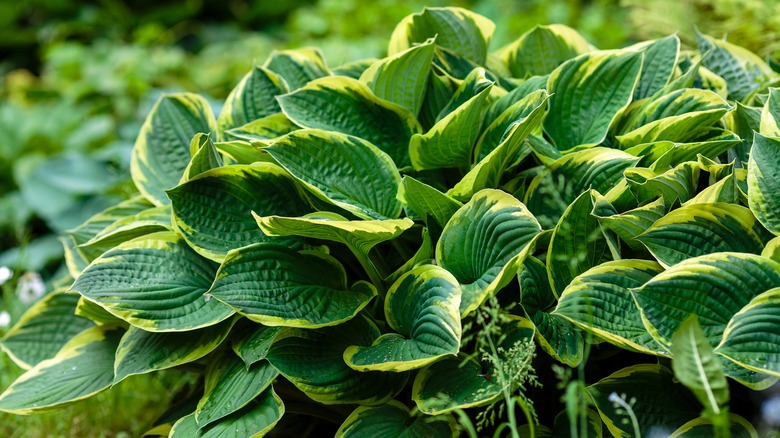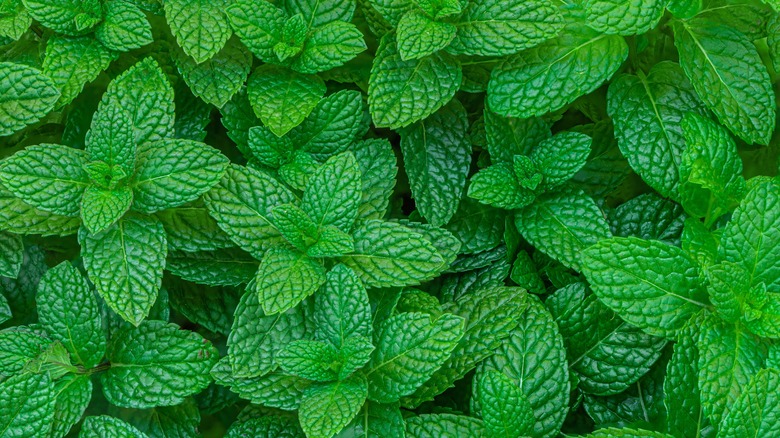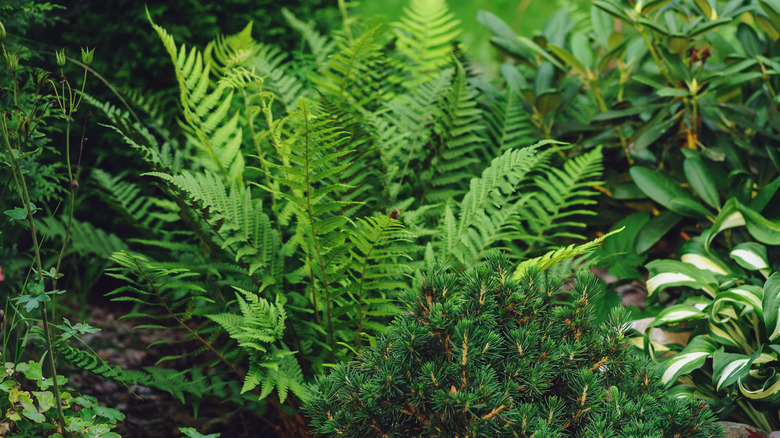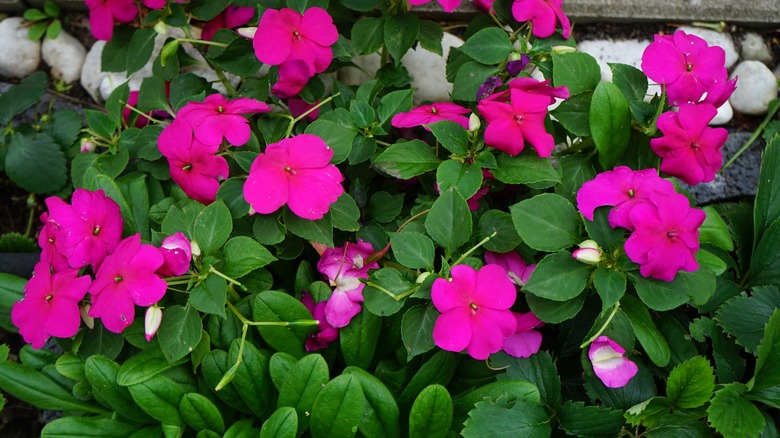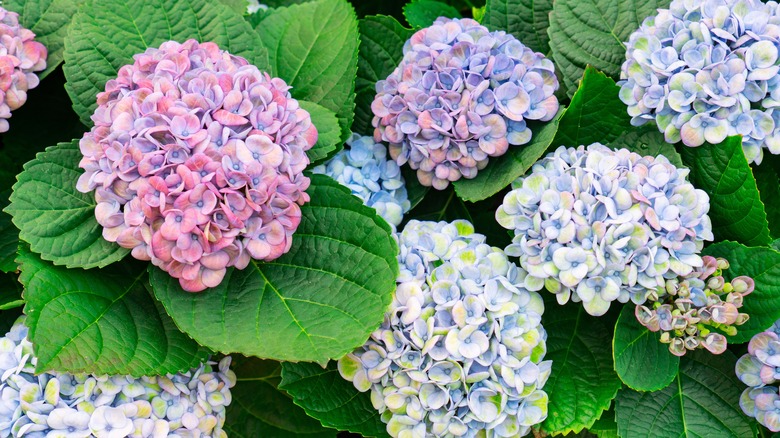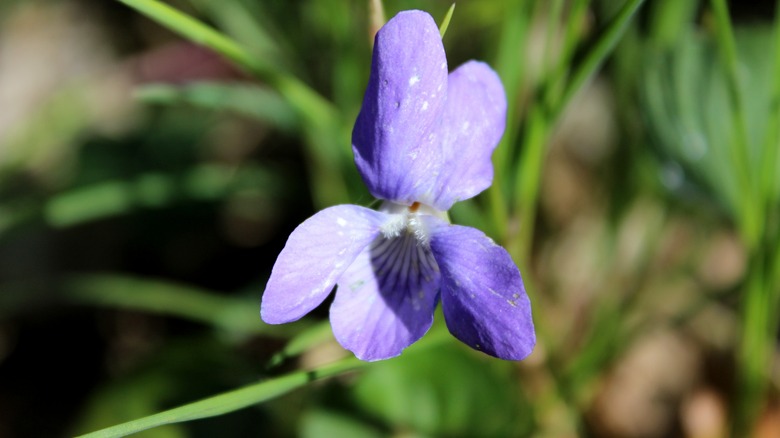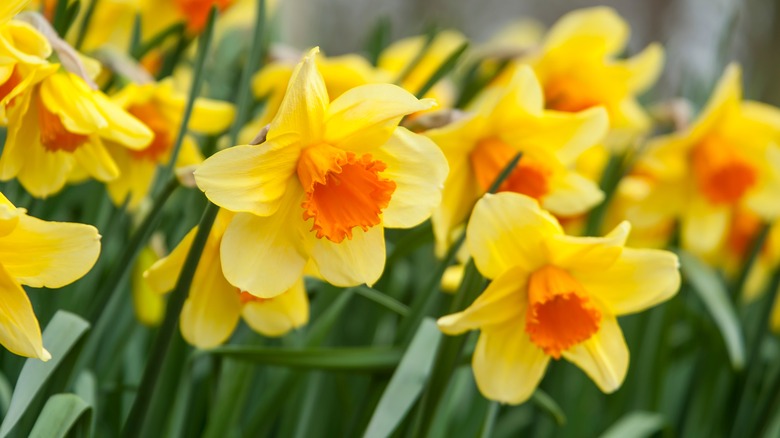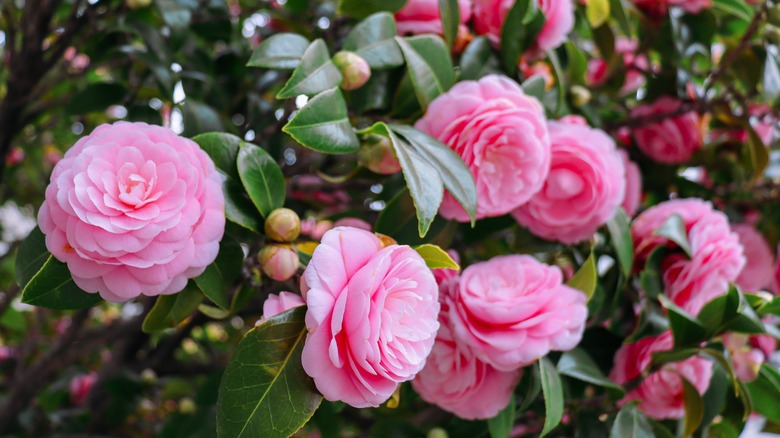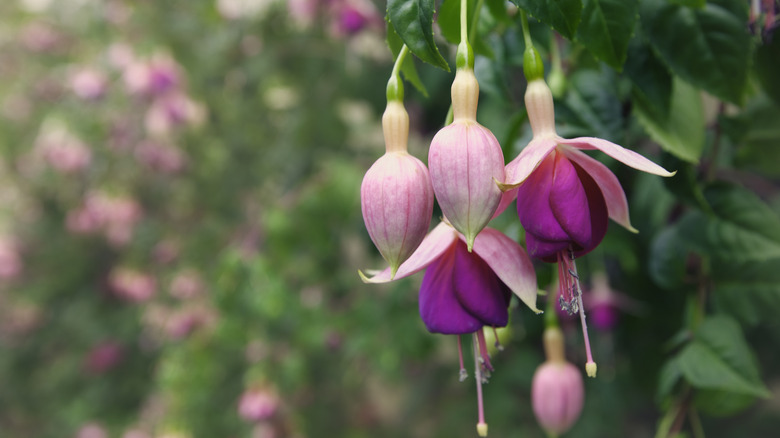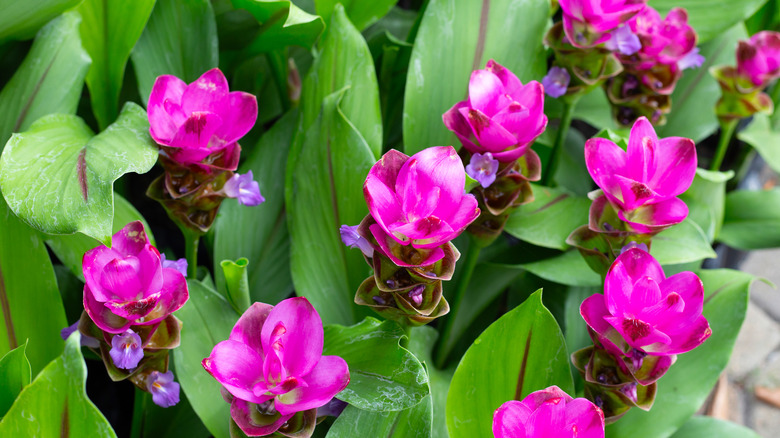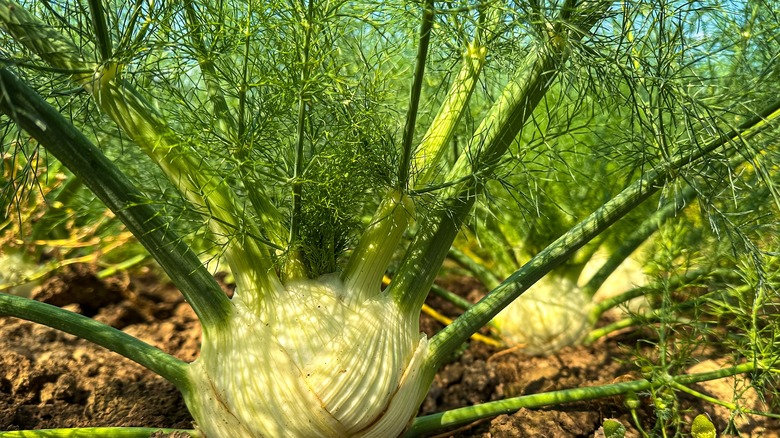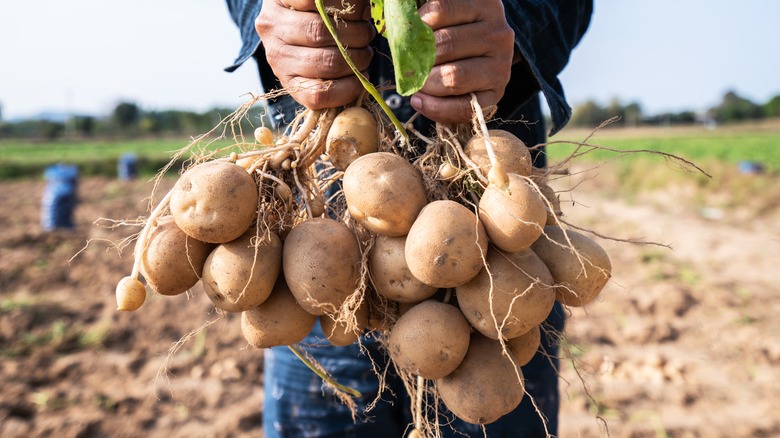Plants You'll Want To Avoid Growing With Lavender In The Garden
When planning your garden it's always a good idea to understand the ways certain plants work together and ones that don't. Lavender (Lavandula) is one of the most popular options for gardens thanks to its bright purple blooms and intoxicating aroma. It easily attracts pollinators like bees and butterflies, making your garden both a functional and beautiful oasis. Plus, it's pretty beginner-friendly since it prefers to be a little neglected. And don't worry about where you live; there are so many varieties that you'll likely be able to find a lavender that thrives in your region.
Still, there's still a limit to its tolerance and ability to play well with other plants. Lavender is so chill when it comes to maintenance that there are plants that can take advantage, stealing its space and nutrients. But which plants will battle with the lavender for dominance? Before you head to the garden center, here are the top plants you need to avoid planting with lavender.
What lavender needs to thrive
First, it's important to understand the growing conditions lavender requires. There are over 450 different varieties of lavandula, but two of the most popular are French (Lavandula dentata) and English (Lavandula angustifolia). Lavandula are native to the Mediterranean but are incredibly hardy. They can grow as a perennial in most USDA zones as long as they get full sun and well-draining soil that's slightly alkaline with a pH of around 7.0.
While drought tolerant, young lavender plants still require monitoring and more water than an established plant will. Once your lavender is established it doesn't require fertilizer. It's also not a big fan of mulch because the extra moisture can make it rot. It isn't necessary, but trimming the plant back as the flowers die off can help it bloom more rigorously. But, all in all, if you want your lavender plant to thrive outdoors, plant it in a well-lit area with well-draining soil and leave it alone.
Hostas want the moisture and shade that lavender hates
Hostas (Hosta plantaginea) are fantastic plants for gardeners of all levels because they will grow nearly everywhere that gets just a little sun. They work great as border plants around your home and can add green in hard-to-garden areas. That weird shady nook between your steps and patio? Bring it — hostas love that space. The open area under your deck stairs? "Yes, please!" says the hosta.
Consequently, that's why they don't pair well with lavender. Hostas will scorch under direct sunlight, which a lavender plant requires. Meanwhile, lavender will wilt and struggle to thrive in the shady conditions hostas love most. If you've already got hostas, try begonias (Begonia), bleeding hearts (Lamprocapnos spectabilis), or clematis (Clematis viticella) instead. If you've already got lavender planted, mondo grass (Ophiopogon japonicus), stonecrop (Sedum), and the purple coneflower (Echinacea purpurea) will work well as hosta alternatives.
Mint requires way more water and may compete for space
Mint (spearmint/Mentha spicata or peppermint/Mentha piperita) is one of the hardiest plants around and is one of the hardest to kill. In fact, some homeowners get so sick of it that they see it more like an invasive weed than an herb. If you're one of those, don't worry. There are still ways to get rid of mint.
Even though lavender and mint are both part of the Lamiaceae family, they're more like distant cousins than siblings because of their care requirements. Mints will require much more water than lavender normally likes. Also, once a mint plant gets established, it can get aggressive fast and overtake a fledgling lavender plant, depriving it of nutrients and light.
If you've already got mint planted, better companion plants include marigolds (Tagetes erecta), or veggie crops like corn (Zea mays), tomatoes (Solanum lycopersicum), and eggplants (Solanum melongena). If you want herbs that will work well with lavender, consider oregano (Origanum vulgare), thyme (Thymus vulgaris), or rosemary (Salvia rosmarinus).
Ferns want much more humidity than lavender can handle
Ferns (Polypodiopsida) are ancient plants; researchers have found fern fossils dating back as far as 430 million years ago! Their ability to thrive in areas that most plants can't proves why they've stood the test of time. Ferns love to hang out on the forest floor, under the canopy where light struggles to reach. Best of all, they thrive most when you leave them alone, making them excellent plants for beginners or forgetful gardeners.
Their ability to grow in dark, moist conditions is the exact reason they can't hang with lavender. Ferns would scorch and die quickly in lavender's preferred bright sun. Meanwhile, lavender would rot quickly in the humid, shady conditions ferns love to live in. If you've already planted ferns, consider hostas (Hosta plantaginea), creeping Jenny (Lysimachia nummularia), or azaleas (Rhododendron L.). On the other hand, white sage (Artemisia ludoviciana), blue fescue (Festuca glauca), and mugwort (Artemisia vulgaris) are all plants that somewhat resemble ferns and pair better with lavender.
Impatiens need shadier spots than lavender likes
Impatiens (impatiens walleriana) have beautiful bursts of colors that will bloom from spring until the first frost. Their ability to be happy in the shadier spots of your garden makes them favorites for people with low light conditions. Since they grow in small mounds, they're excellent flowers that won't spread out of control, letting you thoughtfully plan your garden design.
Unfortunately, impatiens get really stressed in the high sun requirements of lavender and will wilt quickly. Plus, their love of moist soil conditions makes it hard for lavender and impatiens to successfully coexist in the same spot. If you'd like to use better companion plants for impatiens, consider woodland forget-me-nots (Myosotis sylvatica), holly (Ilex opaca), or azaleas (Rhododendron). If you'd like pops of color next to your lavender plants, oleander (Nerium), stonecrop (Sedum), and red valerian (Centranthus ruber) would make excellent impatiens replacements.
Hydrangeas water requirements could stress lavender plants
Have you ever wondered what the soil is like around your home? You could do a bunch of testing but just plant a hydrangea bush (Hydrangea macrophylla) instead. Why? These gorgeous bushes will change the color of their flowers based on the pH level of your soil. Acidic soil (pH lower than 6.0) will create blue or purple hydrangea blooms. If your hydrangea ends up with red or pink blooms, then that means you've got alkaline soil instead (pH levels of 7.0+). Of course, there are ways you can adjust the pH levels of soil, too, if you want to change your hydrangea's colors.
They may be able to thrive in a variety of pH soil levels, that doesn't mean hydrangea can hang with lavender. The problem is right in the name, "hydra." Hydrangeas love water and won't tolerate the drought conditions that lavender can. Plus, the growth of these two bushy plants can mean competing for space quickly. Better companion plants for hydrangeas would be azaleas (Rhododendron), begonias (Begonia), and foxgloves (Digitalis). If you're trying to replicate hydrangeas globe-like blooms around lavender, try alliums (Allium sativum) instead.
Violets need shadier spots than sun-loving lavender
Violets (Violaceae) technically aren't their own species but instead are a genus of flowers that include violas (Viola), sweet violets (Viola ordorata), and pansies (Viola × wittrockiana). Regardless, the whole family is full of easy-to-care-for flowers that can grow quickly without much oversight. You might even find them around your lawn since wild violets are infamous for growing and spreading quickly. They're also one of the first blooms to show up thanks to their ability to handle colder temperatures, have over 500 species, and come in a rainbow of colors.
However, violets need much more shade than lavender and can burn their flowers quickly if they get too much light. Bleeding hearts (Lamprocapnos spectabilis), forget-me-not (Myosotis sylvatica), and English daisies (Bellis perennis) pair much better with violets than lavender. If you want similar colors that violets produce to give your lavender some contrast, try zinnias (Zinnia) instead since they prefer lots of sun.
Daffodils may get too aggressive for soil space with lavender
They're often the first sign of spring! Daffodils' (Narcissus pseudonarcissus) bright yellow flowers are easy to grow and bring cheer to those who are just completely over dealing with winter. But daffodils aren't just a pretty face; they also act as natural deterrents to squirrels and rodents. That's typically why gardening experts consider them to be perfect border flowers for homes and crops.
Despite them being flowers with beautiful complimentary colors lavender and daffodils just don't mix. Daffodils have aggressive growth patterns and can overtake fledging lavender, pushing it out of its space and sucking up nutrients. If you want to add a little purple to your yellow blooms, try catnip (Nepeta cataria), tulips (Tulipa), or hyacinth (Hyacinthus orientalis). On the other hand, lavender cotton (Santolina chamaecypariussus), black-eyed Susans (Rudbeckia hirta), and red hot pokers (Kniphofia) can add pops to yellow next to your lavender.
Camellia needs more tropical growing conditions than lavender likes
Camellia (Camellia japonica) are gorgeous shrubs with distinct flowers that come in a variety of colors. They're prized for their ability to give one last flush of color to gardens thanks to their typical bloom seasons of fall and sometimes even winter. They're also one of the best shrubs to grow in deer country since the woodland animals typically avoid them.
Despite them being prized flowers in the American South, camellias aren't as sun-loving as lavender. They typically require more shade and humidity than lavender likes. Even meeting in the middle with growing requirements would cause stress to both plants since they'll compete for resources thanks to their aggressive growth. Instead, pair camellia with witch hazel, honeysuckle (Lonicera fragrantissima), or woodland phlox (Phlox divaricata). On the other hand, if you've already got lavender planted then opt for roses (Rosa spp.) as an alternative to camellia.
Fuschia is too high maintenance for lavender
Fuschia (Fuchsia magellanica) is a genus of flowering shrub that has beautiful pops of hot pink and purple, showing why its downturned flowers are stunning examples of its matching color name. They're known butterfly and hummingbird attractors that last throughout the summer months and look lovely in garden beds or hanging baskets. While native to Central and South America, fuschia are hardy plants that can be annual or perennial, depending on the growing area. They're bushy shrubs that will grow up to two feet every year and will bloom in all directions.
However, fuschias are fussy little things. They're not remotely drought-tolerant and require regular fertilization to bring back their blooms. Both of these things are problems for lavender which just prefers to be left alone. Cosmos (Cosmos), impatiens (Impatiens walleriana), and lobelia (Lobelia erinus) do much better with fuschia than lavender. If you want that hot pink color next to your lavender, try sea thrift (Armeria maritima) instead.
Turmeric loves moist climates that can cause lavender to rot
Cooks know turmeric (Curcuma longa) as a spice that can add flavor to any meal. But gardeners know it for a different reason: it's stunning magenta bracts. The stems can grow as high as 7 feet in spring and on the tip, these bracts open up to showcase delicate little flowers.
Turmeric is native to Asia and grows best during the ultra-wet monsoon season. Considering all of these factors, you can probably guess why it's not a good idea to be grown with lavender. Turmeric requires moist soil and repeated fertilization which simply won't do for lavender. Instead, pick a more appropriate companion plant for turmeric like lemongrass (Cymbopogon citratus), cardamom (Elettaria cardamomum), or hibiscus (Hibiscus rosa-sinensis). On the flip side, geranium (Pelargonium × domesticum) or yarrow (Achillea millefolium) will look great alongside lavender while producing similar colors to turmerics' bracts.
Corn could steal your lavender's nutrients
Excellent for new farmers or little farmer helpers, corn (Zea mays) is relatively easy to grow, tasty, and can yield crops as quickly as 60 days after planting. While it requires a lot of space, some advanced-level container farmers have been able to make it work in pots, too. Considered to be one of the original companion plants (it's one of the Three Sisters), it's been helping neighbor plants and crops to thrive for centuries.
Unfortunately, that doesn't mean it's universally compatible because of one reason — nutrients. Corn is notoriously hungry for nutrients and needs to be fertilized often, which could be a problem for lavender. Instead, try planting more veggies around your corn that have the same fertilizer requirements, like the other two sisters: beans (Phaseolus vulgaris) and squash (Cucurbita). If you want to grow veggies around your lavender try broccoli (Brassica oleracea), olives (Olea europaea), celery (Apium graveolens), and bell peppers (Capsicum annuum).
Fennel has a secret weapon that could hurt your lavender
Originally from the Mediterranean, fennel (Foeniculum vulgare) has been one of the most popular herbs to grow in a garden for centuries. It's so versatile and hardy that archaeologists have even found uses of fennel dating back to Ancient Greece. This makes sense, since its hardy root is rough and will grow deep in soil to ensure its regrowth every year. It will bloom starting in its second year and produces tiny, yellow flowers.
However, fennel has a dirty little secret that could kill your lavender. It contains allelopathic properties, which are chemicals that will inhibit the growth of other plants around it in order to get the best growing conditions possible for itself. Because of this, it's better to grow it around plants that can withstand these chemicals, like mint (Lamiaceae), sage (Salvia officinalis), or dill (Anethum graveolens). There are better herbs that will happily grow alongside lavender like rosemary (Salvia rosmarinus) or thyme (Thymus vulgaris).
Potatoes are too finicky, even for hardy lavender plants
Hardy, delicious, and able to adapt to most soil conditions, let's hear it for the potato (Solanum tuberosum)! Potatoes grow under the soil and can do their own thing with very little intervention from the gardener, making them great for little farmers or beginner gardeners. Plus, there are over 100 varieties with different harvest times, meaning you'll be able to keep your potato stash going throughout the year. That's the good news.
The bad news is that potatoes are especially susceptible to pest infestations and can put stress on lavender, inhibiting its growth. Because of this, potatoes really need companion plants that can give them a helping hand. Sweet alyssum (Lobularia maritima) and petunias (Petunia × hybrida) can attract beneficial insects that prey on pests. Carrots (Daucus carota subsp. sativus) and onions (Allium cepa) are better underground companions for lavender as they'll appreciate its ability to attract pollinators and can handle the reduced water requirements it has.
